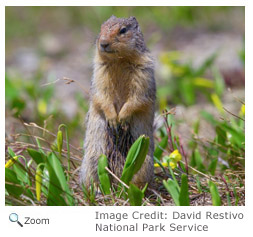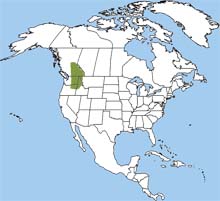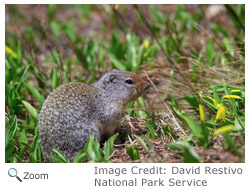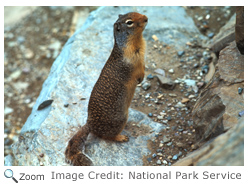Characteristics
 The Columbian ground squirrel has white-speckled brown, black and gray fur on its head and back. It has reddish-tan fur on its face and nose, chest, undersides and legs. It has a reddish-black tail and white around its eyes. The Columbian ground squirrel has white-speckled brown, black and gray fur on its head and back. It has reddish-tan fur on its face and nose, chest, undersides and legs. It has a reddish-black tail and white around its eyes.
Range
 The Columbian ground squirrel can be found in Canada in eastern British Columbia and Western Alberta. In the United States, it can be found in eastern Oregon and Washington, northern Idaho and western Montana. The Columbian ground squirrel can be found in Canada in eastern British Columbia and Western Alberta. In the United States, it can be found in eastern Oregon and Washington, northern Idaho and western Montana.
Habitat
The Columbian ground squirrel can be found in open alpine meadows, dry grasslands and brushy areas.
Diet
 The majority of the Columbian ground squirrel's diet is made up of grasses and plant parts like stems, leaves, bulbs, fruits and seeds. Occasionally it will eat birds, insects and other small animals. The majority of the Columbian ground squirrel's diet is made up of grasses and plant parts like stems, leaves, bulbs, fruits and seeds. Occasionally it will eat birds, insects and other small animals. |
|
|
Life Cycle
Mating season is in the early spring after the squirrels awake from hibernation. Males come out of hibernation first. The females will wake up a week later.
The female will have three to five babies in May or June. Females that live in lower elevations usually give birth to more babies than females that live in higher elevations. The babies have hair after about three days. In about two weeks they can walk and climb. They are weaned after about a month, but will stay near their mother through their first winter.
Behavior
 Columbian ground squirrels live in colonies. Females usually stay with the colony they were born into, males will leave their birth colony.
The Columbian ground squirrel hibernates seven or eight months out of the year. It may begin hibernating as early as July. It has a special hibernation chamber in its burrow that is sealed off from the rest of the burrow with a plug of dirt. It puts on fat in the summer and stores seeds and bulbs in its hibernation chamber to eat when it wakes up in the spring.
|